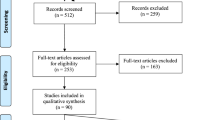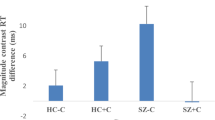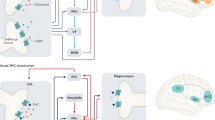Abstract
Substance cue reactivity is theorized as having a significant role in addiction processes, promoting compulsive patterns of drug-seeking and drug-taking behavior. However, research extending this phenomenon to cannabis has been limited. To that end, the goal of the current work was to examine the relationship between cannabis cue reactivity and craving in a sample of 353 participants varying in self-reported cannabis use. Participants completed a visual oddball task whereby neutral, exercise, and cannabis cue images were presented, and a neutral auditory oddball task while event-related brain potentials (ERPs) were recorded. Consistent with past research, greater cannabis use was associated with greater reactivity to cannabis images, as reflected in the P300 component of the ERP, but not to neutral auditory oddball cues. The latter indicates the specificity of cue reactivity differences as a function of substance-related cues and not generalized cue reactivity. Additionally, cannabis cue reactivity was significantly related to self-reported cannabis craving as well as problems associated with cannabis use. Implications for cannabis use and addiction more generally are discussed.
Similar content being viewed by others
Log in or create a free account to read this content
Gain free access to this article, as well as selected content from this journal and more on nature.com
or
References
Achenbach TM (2009) The Achenbach System of Empirically Based Assessment (ASEBA): Development, Findings, Theory, and Applications. University of Vermont Research Center for Children, Youth, and Families: Burlington, VT.
Anthony JC, Warner LA, Kessler RC (1994). Comparative epidemiology of dependence on tobacco, alcohol, controlled substances, and inhalants: Basic findings from the National Comorbidity Survey. Exp Clin Psychopharmacol 2: 244–268.
Bartholow BD, Henry EA, Lust SA (2007). Effects of alcohol sensitivity on P3 event-related potential reactivity to alcohol cues. Psychol Addict Behav 21: 555–563.
Bartholow BD, Lust SA, Tragesser S (2010). Specificity of P3 event-related potential reactivity to alcohol cues in individuals low in alcohol sensitivity. Psychol Addict Behav 24: 220–228.
Bohn MJ, Krahn DD, Staehler BA (1995). Development and initial validation of a measure of drinking urges in abstinent alcoholics. Alcohol Clin Exp Res 19: 600–606.
Carpenter KM, Schreiber E, Church S, McDowell D (2006). Drug Stroop performance: relationships with primary substance of use and treatment outcome in a drug-dependent outpatient sample. Addict Behav 31: 174–181.
Carter BL, Tiffany ST (1999). Meta-analysis of cue-reactivity in addiction research. Addiction 94: 327–340.
Claus ED, Blaine SK, Filbey FM, Mayer AR, Hutchison KE (2013). Association between nicotine dependence severity, BOLD response to smoking cues, and functional connectivity. Neuropsychopharmacology 38: 2363–2372.
Cloninger CR, Svrakic DM, Przybeck TR (1993). A psychobiological model of temperament and character. Arch Gen Psychiatry 50: 975–970.
Colorado Amendment 64 (2012). Amendment 64: Use and Regulation of Marijuana http://www.colorado.gov/cs/Satellite?blobcol=urldata&blobheader=application%2Fpdf&blobkey=id&blobtable=MungoBlobs&blobwhere=1251834064719&ssbinary=true.
Crean RD, Crane NA, Mason BJ (2011). An evidence based review of acute and long-term effects of cannabis use on executive cognitive functions. J Addict Med 5: 1–8.
Dunning JP, Parvaz MA, Hajcak G, Maloney T, Alia-Klein N, Woicik PA et al (2011). Motivated attention to cocaine and emotional cues in abstinent and current cocaine users – an ERP study. Eur J Neurosci 33: 1716–1723.
D’Souza DC, Fridberg DJ, Skosnik PD, Williams A, Roach B et al (2012). Dose-related modulation of event-related potentials to novel and target stimuli by intravenous delta super(9)-THC in humans. Neuropsychopharmacology 37: 1632–1646.
Field M, Cox WM (2008). Attentional bias in addictive behaviors: a review of its development, causes, and consequences. Drug Alcohol Depend 97: 1–20.
Field M, Eastwood B, Bradley BP, Mogg K (2006). Selective processing of cannabis cues in regular cannabis users. Drug Alcohol Depend 8: 75–82.
Field M, Munafo MR, Franken IHA (2009). A meta-analytic investigation of the relationship between attentional bias and subjective craving in substance abuse. Psychol Bull 135: 589–607.
Franken IHA, Dietvorst RC, Hesselmans M, Franzek EJ, van de Wetering BJ, Van Strien JW (2008). Cocaine craving is associated with electrophysiological brain responses to cocaine-related stimuli. Addict Biol 13: 386–392.
Grotenhermen F (2003). Pharmacokinetics and pharmacodynamics of cannabinoids. Clin Pharmacokinet 42: 327–360.
Haney M, Ward AS, Comer SD, Foltin RW, Fischman MW (1999). Abstinence symptoms following smoked marijuana in humans. Psychopharmacology 141: 395–404.
Hajcak G, MacNamara A, Olvet DM (2010). Event-related potentials, emotion, and emotion regulation: an integrative review. Dev Neuropsychol 35: 129–155.
Ito TA, Larsen JT, Smith NK, Cacioppo JT (1998). Negative information weighs more heavily on the brain: The negativity bias in evaluative categorizations. J Personality Social Psychol 75: 887–900.
Johnson V, White HR (1989). An investigation of factors related to intoxicated driving behaviors among youth. J Studies Alcohol 50: 320–330.
Kandel D (1975). Stages in adolescent involvement in drug use. Science 190: 912–914.
Latimer WW, Winters KC, Stinchfield R, Traver RE (2000). Demographic, individual, and interpersonal predictors of adolescent alcohol and marijuana use following treatment. Psychol Addict Behav 14: 162–173.
Littel M, Euser AS, Munafo MR, Franken IHA (2012). Electrophysiological indices of biased cognitive processing of substance-related cues: A meta-analysis. Neurosci Biobehav Rev 36: 1803–1816.
Littel M, Franken IHA (2007). The effects of prolonged abstinence on the processing of smoking cues: An ERP study among smokers, ex-smokers and never-smokers. J Psychopharmacol 21: 873–882.
McFadden KL, Healy KM, Dettmann ML, Kaye JT, Ito TA, Hernandez TD (2011). Acupressure as a non-pharmacological intervention for traumatic brain injury (TBI). J Neurotrauma 28: 1–14.
Meier MH, Caspi A, Ambler A, Harrington H, Houts R, Keefe RS et al (2012). Persistent cannabis users show neuropsychological decline from childhood to midlife. Proc Natl Acad Sci USA 109: 15970–15971.
Namkoong K, Lee E, Lee CH, Lee BO, An SK (2004). Increased P3 amplitudes induced by alcohol-related pictures in patients with alcohol dependence. Alcohol Clin Exp Res 28: 1317–1323.
National Institute on Drug Abuse (2013). Adolescent cigarette, alcohol use declines as marijuana use rises http://www.drugabuse.gov/news-events/nida-notes/2013/02/adolescent-cigarette-alcohol-use-declines-marijuana-use-rises.
Nickerson LD, Ravichandran C, Lundahl LH, Rodolico J, Dunlap S, Trksak GH et al (2011). Cue reactivity in cannabis-dependent adolescents. Psychol Addict Behav 25: 168–173.
Petit G, Kornreich C, Verbanck P, Campanella S (2013). Gender differences in reactivity to alcohol cues in binge drinkers: A preliminary assessment of event-related potentials. Psychiatry Res 209: 494–503.
Robinson TE, Berridge KC (1993). The neural basis of drug craving: An incentive-sensitization theory of addiction. Brain Res Rev 18: 247–291.
Sobell LC, Sobell MB (1992). Timeline Follow-back: A technique for assessing self-reported ethanol consumption. In Allen J,, Litten RZ (eds) Measuring Alcohol Consumption: Psychosocial and Biological Methods. Humana Press: Totowa, NJ. pp 41–72.
Stephens RS, Roffman RA, Curtin L (2000). Comparison of extended versus brief treatments for marijuana use. J Consult Clin Psychol 68: 898–908.
Substance Abuse and Mental Health Services Administration (2010). Results from the 2009 National Survey on Drug Use and Health. Department of Health and Human Services: Rockville.
Washington Initiative 502 (2012). Summary of Initiative 502 http://www.leg.wa.gov/House/Committees/OPRGeneral/Documents/2012/I-502%20summary.pdf.
Willcutt EG, Bidwell LC (2011). Etiology of ADHD: implications for assessment and treatment. In Hoza B, Evans SW (eds) Treating Attention Deficit Hyperactivity Disorder. Civic Research Institute: Kingston, NJ. pp 6-2–6-18.
Wölfling K, Flor H, Grüsser SM (2008). Psychophysiological responses to drug associated stimuli in chronic heavy cannabis use. Eur J Neurosci 27: 976–983.
Yeung N, Sanfey AG (2004). Independent coding of reward magnitude and valence in the human brain. J Neurosci 24: 6258–6264.
Acknowledgements
This research was supported by a grant from the National Institute on Drug Abuse (R01 DA024002, Tiffany Ito PI).
Author information
Authors and Affiliations
Corresponding author
Additional information
Supplementary Information accompanies the paper on the Neuropsychopharmacology website
Supplementary information
PowerPoint slides
Rights and permissions
About this article
Cite this article
Henry, E., Kaye, J., Bryan, A. et al. Cannabis Cue Reactivity and Craving Among Never, Infrequent and Heavy Cannabis Users. Neuropsychopharmacol 39, 1214–1221 (2014). https://doi.org/10.1038/npp.2013.324
Received:
Revised:
Accepted:
Published:
Issue date:
DOI: https://doi.org/10.1038/npp.2013.324
Keywords
This article is cited by
-
Cannabis use and psychosis among patients hospitalized in psychiatric wards in Lebanon: a retrospective chart review
Middle East Current Psychiatry (2023)
-
Gaming Disorder Is a Disorder due to Addictive Behaviors: Evidence from Behavioral and Neuroscientific Studies Addressing Cue Reactivity and Craving, Executive Functions, and Decision-Making
Current Addiction Reports (2019)
-
Appetitive startle modulation in the human laboratory predicts Cannabis craving in the natural environment
Psychopharmacology (2018)
-
Neurobiology of Craving: Current Findings and New Directions
Current Addiction Reports (2018)
-
Mechanisms Underlying Sex Differences in Cannabis Use
Current Addiction Reports (2017)



